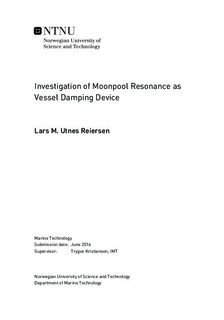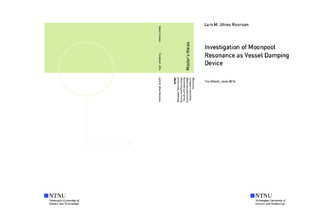| dc.description.abstract | The starting point of this thesis is to introduce the potential and the viscous flow formulations of a two-dimensional moonpool geometry, and the viscous approach demonstrates compliance with physical experiments. The dynamics of a three degrees of freedom system are explained through the 3x3 coupled equation of motion, and the undamped homogeneous solution is later employed to solve the systems eigenvalue problem.
Both a numerical simulation and a physical experiment of the radiation problem in heave
and pitch are carried out for the model scale of a bridge pontoon. The CFD problem is conducted in an OpenFOAM extension, PVC3D, while the model test is performed in a wave flume
at Marine Technology Centre. The tests investigate the piston mode of motion and involve a
parameter study of five moonpool inlets, two drafts, and three forced amplitudes. The following inlets are employed: rounded, squared and three different vertical appendages.
In general, there is a satisfactory result between the numerical study and the experiments.
The parameter analysis displays that the rounded inlet corners give rise to large water elevations inside the gaps, while the designs with geometrical singularities introduce vortex shedding and non-linear damping contributions resulting in smaller water responses. The effective draft changes with the inlet configurations and introduces a shift in the natural periods. The draft parameter study supports this finding, and a smaller draft triggers resonance for lower periods.
The second experiment is the spring-moored freely-floating moonpool geometry subjected
to incoming regular waves, free to move in surge, heave, and pitch. The corresponding numerical results are obtained from Arnt Fredriksen s fully nonlinear hybrid scheme. A first observation is that the solution of the eigenvalue problem corresponds to the resonance peaks in heave and pitch. No resonant water motion occurs around the piston-mode resonance frequencies of the moonpools. Further, a cancellation in the heave and the pitch RAOs are experienced for particular incoming wave periods, especially for round and square inlets. This is connected to the pressure- and flow field of the moonpools, and the effects are most prominent when the moonpool wave elevations and rigid-body motions are 90 degrees out of phase with each other. Hence, the installation can be thought of as an integrated anti-pitch tank, and the bridge floaters will exert advantageous hydrodynamic properties in a given range of the incoming ocean swells. | |

